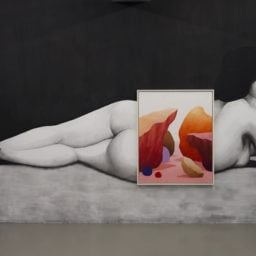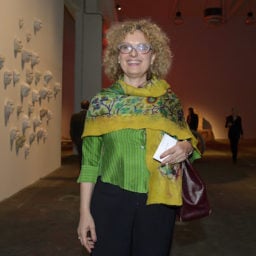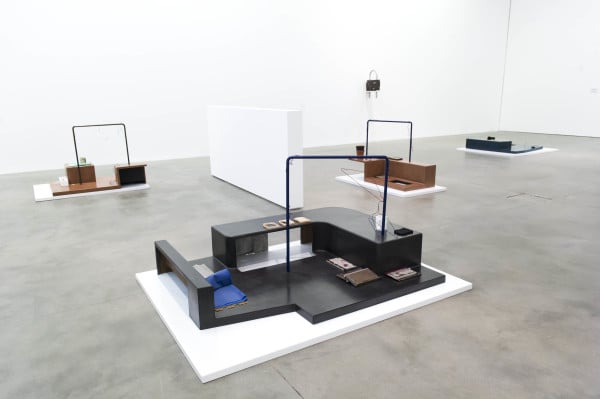
Magali Reus In Place Of (Sundries), (2015)
Photo: Giorgio Perottino, Courtesy Fondazione Sandretto Re Rebaudengo
There’s much to be gained from squatting in front of a Magali Reus sculpture. Not meant to be viewed from any particular single point in space, the works in her solo show at the Fondazione Sandretto Re Rebaudengo in Turin do well to convey the artist’s pre-occupation with our physicality, and the way it affects individual perceptions of our surroundings.
The show brings to Italy the recent body of work co-commissioned by SculptureCenter, New York; the Hepworth Wakefield in Yorkshire, UK; Westfälischer Kunstverein in Münster, Germany; and the Fondazione Sandretto Re Rebaudengo in Turin, and includes the series “Leaves” of wall-mounted works resembling padlocks, and the floor pieces “In Place of” (all works 2015) that tempt the viewer not to merely move around them, but also to kneel down and explore their familiar-seeming details.
The sculptures are arranged around the exhibition space and in the hallway leading to it according to specific themes evoked by the details of the floor pieces; there are two waist-high divides demarcating the groups. A sculpture titled In Place Of (Appetites) resembles a domestic kitchen scene, with dishes stacked on a drying rack and charred charcoal tucked in a hollow that could be a grill. In Place of (Sunday Spills) on the other hand includes references to playgrounds, leisure, and recreation.
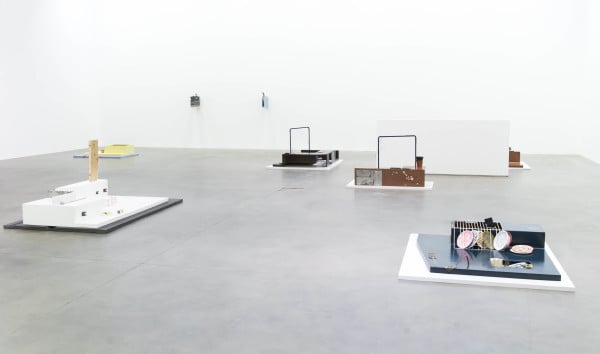
Installation view of Magali Reus, “Quarters,” at Fondazione Sandretto Re Rebaudengo
Photo: Giorgio Perottino
Familiarity, and Reus’s allusions to commonplace objects are largely responsible for the works’ proverbial gravitational pull—perhaps just as much as their sleekness, which gives them the “miniature-world” appeal of architectural models. Because rather than found objects, every single item that is carefully positioned on the low platforms is the product of a slow, studio-based process.
“The forms of these bases were very loosely drawn from shapes and sizes found in the urban architecture of the street curb: Pavements, ramps, manhole covers, gutters, etc,” Reus explains. “Choosing the color of the bases followed the computer 3D renders and this was highly determining because it imbued the shape with a sense of temperature and the first step towards finding its context,” she adds.
The curb-like bases are elevated ever so slightly by substructures acting like flattened plinths, or stages, where narratives—both tragic and comic—slowly unfold. It is fascinating how vast the range of emotions these sculptures inspire, and the artist’s ability to fine tune the unique atmosphere of each piece by merely alluding to traces of human activity, never repeating the same delicate manipulation twice.
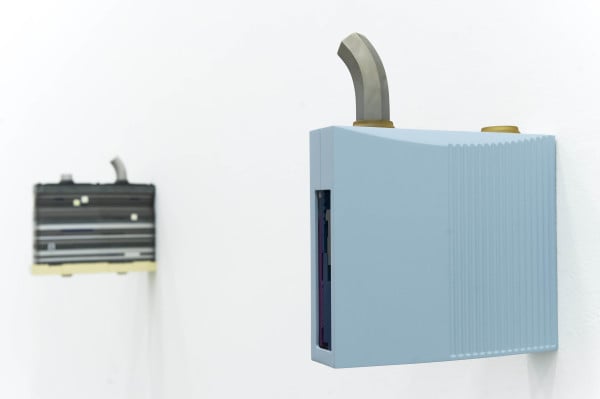
Magali Reus Leaves (Peat, March), (2015)
Photo: Giorgio Perottino, Courtesy Fondazione Sandertto Re Rebaudengo
Works from the series “Leaves” jut out from the walls around the space at eye-level. Their protruding creates the notion of a closed space fortified by huge locks. In stark contrast to the floor pieces, these are self-contained works whose presence appears confrontational.
“I thought of them as sculptural busts, as portraiture of our age of information whereby our physical selves have become increasingly redundant as we find our new selves operating on screen or interface level,” Reus explains. The meticulously executed sculptures are made of multiple layers and sometimes include up to 100 parts. The structure and its mechanisms are exposed by cut-away areas,” allowing for glimpses into the inside layers or the internal workings of the structures that contain them,” she says.
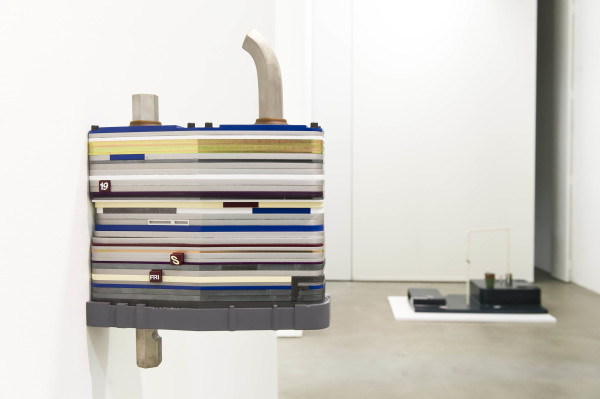
Magali Reus Leaves (Flint Levels, April), (2015)
Photo: Giorgio Perottino, Courtesy Fondazione Sandertto Re Rebaudengo
Having won the Prix de Rome award in 2015, the Dutch-born, London based artist, who’s been a curators’ darling for nearly a decade now, has been having a stellar run of institutional shows lately. This fall, Reus will get a solo exhibition at the Stedelijk museum in Amsterdam. The attention is well-deserved; hers is a remarkably lucid voice that recounts the vastness of human experience, in which the refined and the abject coexist.
“Magali Reus, Quarters” is on view at Fondazione Sandretto Re Rebaudengo, Turin, from March 31 – June 12, 2016







